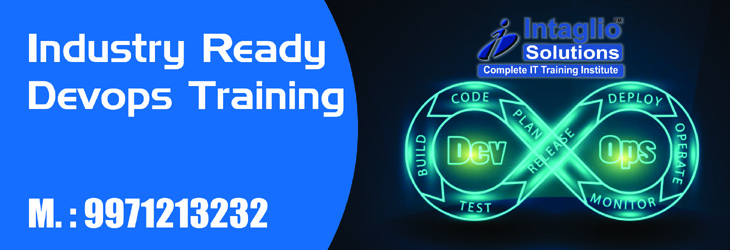
Course contents devops 2019 Training:
Course Duration : 40 Hours
The DevOps Training at Intaglio is designed keeping in mind the latest market trend. This course will provide you with the in-depth knowledge of various DevOps tools including Git, Jenkins, Selenium, Puppet, Ansible, Docker, Kubernetes and Nagios. This training is completely hands-on oriented and designed in way that will help you in becoming a certified practitioner by providing you with an intensified training for the best practices about Continuous Development, Continuous Integration, Continuous Testing, Configuration Management, Continuous Deployment and finally Continuous Monitoring of the software throughout its development life cycle.
DevOps Training Courses Content
Introduction to Devops
Module 1
Version control with GIT
• What is version control
• What is Git
• Why Git for your organization
• Install Git
• Common commands in Git
• Working with Remote Repositories
Module 2: Git, Jenkins and Maven
• Branching and Merging in Git
• Git workflows
• Git cheat sheet
• What is CI
• Why CI is Required
• Introduction to Jenkins (With Architecture)
• Introduction to Maven
Module 3: Continuous Integration using Jenkins
• Jenkins Management
• Build Setup
• Test Automation (with Maven)
• Securing Jenkins
• Notification System
• Adding a slave node to Jenkins
• Building Delivery Pipeline
• Jenkins to run script remotely
• Add jenkins node/slave
• Run Jenkins behind apache proxy
Module 4: Continuous Testing with selenium
• Introduction to Selenium
• Why Selenium?
• Selenium – Webdriver
• Creating Test Cases in Selenium WebDriver (Waits)
• What and why is X-Path?
• Handling different controls on Webpage
• Framework in Selenium
• Selenium Integration with Jenkins
Module 5: Configuration Management using puppet
• Introduction to Puppet
• Puppet Installation
• Puppet Configuration
• Puppet Master and Agent Setup
• Puppet Module
• Node Classification
• Puppet Environment
• Puppet Classes
• Automation and Reporting
Module 6: Configuration Management using Ansible
• Introduction to Ansible
• Ansible Installation
• Configuring Ansible Roles
• Write Playbooks
• Executing adhoc command
• Ansible integration with AWS.
Module 7: Containerization with docker
• Shipping Transportation Challenges
• Introducing Docker
• Understanding images and containers
• Running Hello World in Docker
• Introduction to Container
• Container Life Cycle
• Sharing and Copying
• Base Image
• Docker File
• Working with containers
• Publishing Image on Docker Hub
Module 8:- Docket Ecosystem and Networking
• Introduction to Docker Ecosystem
• Docker Compose
• Docker Swarm
• Managing Containers
• Running Containers
• Introduction to Docker Networking
• Network Types
• Docker Container Networking
Module 9:- Containerization using Kubernetes
• Revisiting Kubernetes Cluster Architecture
• Introduction to Kubernetes
• Kubernetes Cluster Architecture
• Spinning up a Kubernetes Cluster on Ubuntu VMs
• Exploring your Cluster
• Understanding YAML
• Creating a Deployment in Kubernetes using YAML
• Creating a Service in Kubernetes
• Installing Kubernetes Dashboard
• Deploying an App using Dashboard
• Using Rolling Updates in Kubernetes
Module 10:- Continuous Monitoring with Nagios
• Introduction to Continuous Monitoring
• Introduction to Nagios
• Installing Nagios
• Nagios Plugins(NRPE) and Objects
• Nagios Commands and Notification